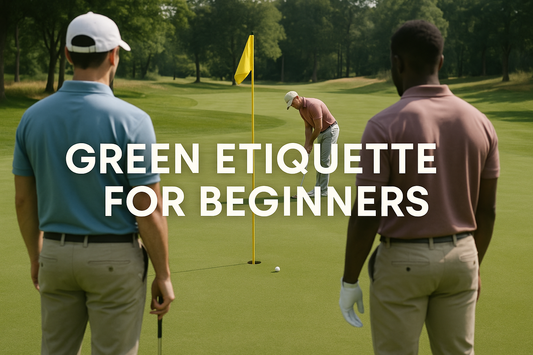After 20 years of teaching golf, I've noticed that new players often focus intensely on swing mechanics while completely overlooking the social aspects of the game. They'll spend hours perfecting their putting stroke but have no idea they're committing etiquette violations that annoy everyone around them.
Here's what I tell every beginner: Golf etiquette isn't about being stuffy or pretentious. It's about respect, safety, and keeping the game enjoyable for everyone. Master these fundamentals, and you'll be welcomed into any foursome, regardless of your skill level.
Understanding Why Etiquette Matters
Golf etiquette exists for three primary reasons: safety, maintaining the pace of play, and ensuring course maintenance. Unlike many sports where officials enforce rules, golf relies on self-policing and mutual respect. When players ignore basic etiquette, it creates frustration, delays, and sometimes dangerous situations.
The green is where etiquette matters most because it's the most delicate part of the course and where players spend significant time. A single thoughtless action can damage the putting surface or disrupt another player's concentration during the most precise shots in golf.
Most etiquette violations stem from inexperience rather than rudeness. Once you understand the reasoning behind these guidelines, following them becomes second nature.
Reading the Green: Position and Movement

Before you even think about your putt, understand where to stand and how to move around the green. Never walk between another player's ball and the hole — this is called walking through someone's line, and it's one of the most common beginner mistakes.
Putting lines extend well beyond the direct path to the hole. Most putts curve, so the actual line might arc several feet to either side of the straight path. When in doubt, walk around the entire area between any ball and the hole, giving it a wide berth.
Move deliberately but efficiently around the green. Avoid sudden movements or loud noises while others are putting. This includes avoiding the temptation to start lining up your putt while someone else is still putting — wait your turn.
Position yourself where you can see the action without interfering with it. Stand still, stay quiet, and keep your shadow off the putting line and the player. These simple courtesies create the calm environment that putting requires.
The Sacred Putting Line

The putting line is the path your ball will travel to the hole, and it's considered sacred territory in golf. Never step on another player's line, even after they've putted. The spike marks and footprints you leave can affect their next putt or the putts of players in groups behind you.
This rule extends to your own equipment. Don't drag your putter across anyone's line, place your golf bag where it might block a line, or lean on your putter in a way that creates indentations near the hole.
If you accidentally step on someone's line, apologize immediately and offer to help repair any damage that may have occurred. Most players are understanding about honest mistakes, especially from beginners who are clearly trying to learn.
The area immediately around the hole is particularly sensitive. Avoid walking or standing within a 3-foot radius of the hole unless you're putting or retrieving your ball.
Marking Your Ball: The Right Way

When your ball is on the green but not the farthest from the hole, you need to mark it so others can putt without your ball interfering. Use a small, flat coin or ball marker placed directly behind your ball — not to the side or in front.
Press the marker firmly into the green to ensure it stays in place, but avoid slamming it down too hard, as this could damage the surface. The marker should be as small and unobtrusive as possible while still being clearly visible.
If your marker is in another player's line, they may ask you to move it. Measure one or two putter head lengths to the left or right using your putter as a guide, then move the marker to that spot. After they putt, remember to move your marker back to its original position before replacing your ball.
Never move your ball to a "better" spot while marking it. The ball must be replaced in exactly the same position, with the same orientation if possible.
Tending the Flag: When and How

The flagstick can be left in the hole or removed entirely — it's your choice. However, once you make that choice for your putt, it applies to everyone putting from on the green until the hole is completed.
If someone asks you to tend the flag, stand to the side of the hole (never straddle it) and hold the flagstick steady. Remove it as soon as the ball is struck, pulling it straight up and away from the hole. Don't let it fall or clatter against the ground.
When removing the flagstick, place it gently on the ground away from all putting lines, preferably on the fringe or rough adjacent to the green. Never throw or drop it carelessly.
If you're the first to putt and want the flag removed, either remove it yourself or ask someone to tend it. Don't assume others will know your preference — communicate clearly.
Repairing the Green: Your Responsibility

Every player has a responsibility to leave the green in better condition than they found it. This means repairing your ball mark (the indentation your ball made when it landed) and any others you might notice.
Use a divot repair tool or tee to gently lift the depressed area back to surface level. Work from the outside edges toward the center, lifting rather than digging. Finish by smoothing the area with your putter.
Ball marks should be repaired immediately after your ball comes to rest, not when you're leaving the green. The sooner you fix them, the faster the grass recovers.
Also, repair any spike marks you might have made, especially near the hole, where they could affect other players' putts. Use your putter to gently smooth down any raised areas.
Order of Play: Who Putts When

The player whose ball is farthest from the hole putts first. This seems simple, but it gets complicated when balls are at similar distances or when someone is putting from off the green.
If you're unsure about the order, ask the other players or suggest, "I think I'm away." Most golfers appreciate this consideration and will help sort out the proper sequence.
Once someone begins their putting routine, remain completely still and quiet until their ball stops moving. This includes not moving toward your ball or starting to line up your putt.
If you sink your putt, quietly retrieve your ball and move away from the hole area. Don't celebrate dramatically or make noise that might disturb others who are still putting.
Pace of Play: Keeping Things Moving

While accuracy is important, don't spend excessive time reading greens or lining up putts. Most beginners can improve their pace simply by being ready when it's their turn.
Start reading your putt while others are putting (from a respectful distance). Have your ball marked and cleaned, and be prepared to putt as soon as it's your turn.
If you're struggling with a particular putt, don't hold up the group by taking numerous practice strokes or re-reading the green multiple times. Pick a line, commit to it, and putt.
Consider picking up your ball if you're taking significantly more strokes than your playing partners. Most casual rounds use some form of maximum score per hole to maintain pace.
Common Beginner Mistakes to Avoid
Don't walk onto the green wearing muddy shoes or immediately after hitting from a sand bunker. Take a moment to clean your shoes or brush off sand before stepping onto the putting surface.
Avoid dragging your feet or making sharp turns that can damage the grass. Lift your feet when walking, and take the shortest reasonable path to your ball.
Don't lean on your putter while waiting or use it as a walking stick. The putter should only contact the green when you're actually putting.
Never throw your ball to someone or roll it across the green. Always hand it to them or place it gently on the ground.
Building Confidence Through Respect
Good etiquette isn't about memorizing a long list of rules — it's about developing awareness and consideration for others. Pay attention to what experienced players do and don't be afraid to ask questions when you're unsure.
Most golfers are happy to help beginners who show genuine interest in learning proper etiquette. A simple "I'm new to golf — could you let me know if I'm doing something wrong?" usually results in helpful guidance rather than criticism.
Remember that everyone was a beginner at some point. The players who seem most natural with etiquette simply developed good habits early in their golf journey.
Making Etiquette Automatic
Like any aspect of golf, good etiquette becomes automatic with practice. Focus on one or two key areas at a time rather than trying to perfect everything immediately.
Start with the basics: respect putting lines, repair ball marks, and maintain appropriate pace. Once these become natural, you can refine the subtler aspects of green etiquette.
The goal isn't to impress anyone with your knowledge of obscure rules — it's to contribute to an enjoyable round for everyone involved. When you can walk onto any green with confidence that you'll behave appropriately, you've mastered one of golf's most important skills.
Great golf etiquette, like great putting, is about developing habits that serve you well in any situation. Master these fundamentals, and you'll always be welcome in any foursome, regardless of how you're scoring.





